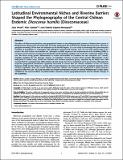Por favor, use este identificador para citar o enlazar a este item:
http://hdl.handle.net/10261/140718COMPARTIR / EXPORTAR:
 SHARE SHARE
 CORE
BASE CORE
BASE
|
|
| Visualizar otros formatos: MARC | Dublin Core | RDF | ORE | MODS | METS | DIDL | DATACITE | |

| Título: | Latitudinal environmental niches and riverine barriers shaped the phylogeography of the Central Chilean endemic Dioscorea humilis (Dioscoreaceae) |
Autor: | Viruel, Juan; Catalán, Pilar; Segarra-Moragues, José G. CSIC ORCID | Fecha de publicación: | 8-oct-2014 | Editor: | Public Library of Science | Citación: | PLoS ONE 9(10): e110029 (2014) | Resumen: | The effects of Pleistocene glaciations and geographical barriers on the phylogeographic patterns of lowland plant species in Mediterranean-climate areas of Central Chile are poorly understood. We used Dioscorea humilis (Dioscoreaceae), a dioecious geophyte extending 530 km from the Valparaíso to the Bío-Bío Regions, as a case study to disentangle the spatio-temporal evolution of populations in conjunction with latitudinal environmental changes since the Last Inter-Glacial (LIG) to the present. We used nuclear microsatellite loci, chloroplast (cpDNA) sequences and environmental niche modelling (ENM) to construct current and past scenarios from bioclimatic and geographical variables and to infer the evolutionary history of the taxa. We found strong genetic differentiation at nuclear microsatellite loci between the two subspecies of D. humilis, probably predating the LIG. Bayesian analyses of population structure revealed strong genetic differentiation of the widespread D. humilis subsp. humilis into northern and southern population groups, separated by the Maipo river. ENM revealed that the ecological niche differentiation of both groups have been maintained up to present times although their respective geographical distributions apparently fluctuated in concert with the climatic oscillations of the Last Glacial Maximum (LGM) and the Holocene. Genetic data revealed signatures of eastern and western postglacial expansion of the northern populations from the central Chilean depression, whereas the southern ones experienced a rapid southward expansion after the LGM. This study describes the complex evolutionary histories of lowland Mediterranean Chilean plants mediated by the summed effects of spatial isolation caused by riverine geographical barriers and the climatic changes of the Quaternary. Copyright: © 2014 Bischoff et al. | Versión del editor: | https://doi.org/10.1371/journal.pone.0110029 | URI: | http://hdl.handle.net/10261/140718 | DOI: | 10.1371/journal.pone.0110029 | Identificadores: | issn: 1932-6203 | Referencias: | Viruel, Juan; Catalán, Pilar; Segarra-Moragues, José G. (2015): Data from: Latitudinal environmental niches and riverine barriers shaped the phylogeography of the central Chilean endemic Dioscorea humilis (Dioscoreaceae) [Dataset]; Dryad; Version 1; https://doi.org/10.5061/dryad.r759h |
| Aparece en las colecciones: | (CIDE) Artículos |
Ficheros en este ítem:
| Fichero | Descripción | Tamaño | Formato | |
|---|---|---|---|---|
| Latitudinal environmental niches_Segarra.PDF | 1 MB | Adobe PDF |  Visualizar/Abrir |
CORE Recommender
PubMed Central
Citations
4
checked on 22-abr-2024
SCOPUSTM
Citations
10
checked on 16-abr-2024
WEB OF SCIENCETM
Citations
10
checked on 26-feb-2024
Page view(s)
246
checked on 24-abr-2024
Download(s)
172
checked on 24-abr-2024

